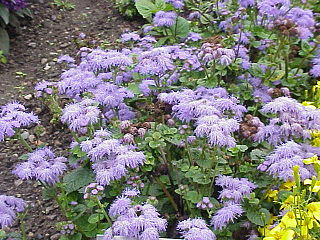
Eupatorieae is a tribe of over 2000 species of plants in the family Asteraceae. Most of the species are native to tropical, subtropical, and warm temperate areas of the Americas, but some are found elsewhere. Well-known members are Stevia rebaudiana, a number of medicinal plants (Eupatorium), and a variety of late summer to autumn blooming garden flowers, including Ageratum (flossflower), Conoclinium (mistflower), and Liatris.

Weinmannia is a genus of trees and shrubs in the family Cunoniaceae. It contains 90 species, which range from Mexico through Central and South America including the Caribbean, and to the Mascarene Islands in the western Indian Ocean. It is absent from mainland Africa and Australia, but some fossils have been attributed to Weinmannia in Australia.

Ayapana is a genus of perennial herbs in the family Asteraceae.

Pitcairnia is a genus of plants in the family Bromeliaceae, subfamily Pitcairnioideae. It was named for William Pitcairn, Scottish physician and gardener (1711–1791). The genus Pitcairnia ranks as the second most prolific of the bromeliad family. They are most abundant in Colombia, Peru and Brazil, but can also be found in areas from Cuba and Mexico south to Argentina. One species, Pitcairnia feliciana, is found in tropical West Africa and is the only member of the family Bromeliaceae not native to the Americas.

Heteropsis is a genus of plants in the family Araceae, native to Central and South America.

Aristeguietia is a genus of about 21 species of flowering plants in the tribe Eupatorieae of the family Asteraceae. It is found from Colombia to southern Peru, with one species in Chile.
Ayapanopsis is a genus of flowering plants in the family Asteraceae.
Cronquistianthus is a genus of shrubs native to the Andes in Colombia, Ecuador, and Peru.
Crossothamnus is a genus of South American flowering plants in the family Asteraceae.
Phalacraea is a genus of South American plants in the tribe Eupatorieae within the family Asteraceae.

Austroeupatorium is a genus of plants native primarily to South America, including herbaceous perennials and shrubs. The native range is focused on eastern South America and extends as far north as Panama and Trinidad and as far west as Bolivia.
Alomia is a genus of flowering plants in the family Asteraceae, described as a genus in 1818.
Condylidium is a genus of flowering plants in the family Asteraceae.
Condylopodium is a genus of flowering plants in the family Asteraceae.
Gongrostylus is a genus of flowering plants in the family Asteraceae.
Idiothamnus is a genus of South American flowering plants in the family Asteraceae.
Lourteigia is a genus of South American flowering plants in the tribe Eupatorieae within the family Asteraceae.
Oxylobus is a genus of Mesoamerican flowering plants in the tribe Eupatorieae within the family Asteraceae.

Piqueria is a genus of Caribbean and Mesoamerican plants in the tribe Eupatorieae within the family Asteraceae.
Polyanthina is a genus of flowering plants in the tribe Eupatorieae within the family Asteraceae.







